
George Catlin was an American adventurer, lawyer, painter, author, and traveler, who specialized in portraits of Native Americans in the Old West.

Gilbert Charles Stuart was an American painter from Rhode Island Colony who is widely considered one of America's foremost portraitists. His best-known work is an unfinished portrait of George Washington, begun in 1796, which is sometimes referred to as the Athenaeum Portrait. Stuart retained the portrait and used it to paint scores of copies that were commissioned by patrons in America and abroad. The image of George Washington featured in the painting has appeared on the United States one-dollar bill for more than a century and on various postage stamps of the 19th century and early 20th century.

Christen Schiellerup Købke was a Danish painter, and one of the best known artists from the Golden Age of Danish Painting.
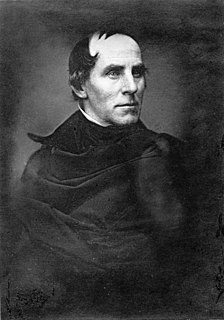
Thomas Cole was an English-American painter known for his landscape and history paintings. He is regarded as the founder of the Hudson River School, an American art movement that flourished in the mid-19th century. Cole's work is known for its romantic portrayal of the American wilderness.

George Romney was an English portrait painter. He was the most fashionable artist of his day, painting many leading society figures – including his artistic muse, Emma Hamilton, mistress of Lord Nelson.
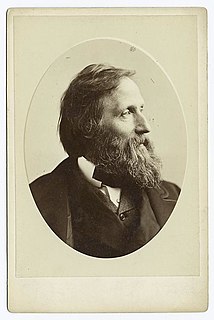
Daniel Huntington was an American artist who belonged to the art movement known as the Hudson River School and later became a prominent portrait painter.
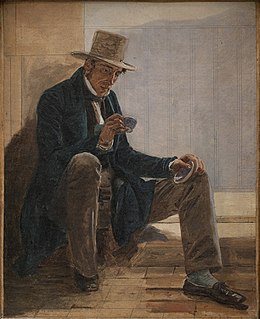
Martinus Christian Wesseltoft Rørbye was a Danish painter, known both for genre works and landscapes. He was a central figure of the Golden Age of Danish painting during the first half of the 19th century.

Jørgen Roed,, Danish portrait and genre painter associated with the Golden Age of Danish Painting, was born in Ringsted to Peder Jørgensen Roed and wife, Ellen Hansdatter.
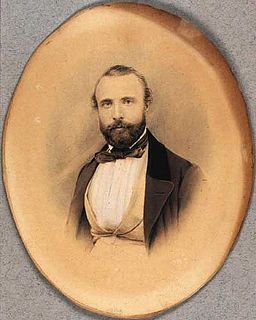
Johan Julius Exner,, Danish genre painter, was born in Copenhagen to Johann Gottlieb Exner, a Czech musician from Bohemia, who came to Denmark during the Napoleonic period, and his wife Karen Jørgensdatter. Exner originally intended on becoming a history painter, but quickly found his niche, however, in genre painting, the most popular and lucrative painting style of his era. His genre paintings figured prominently in Denmark's National Romantic period, an artistic period directly after the Golden Age of Danish Painting, when artistic focus was turned inwards to uniquely Danish themes.
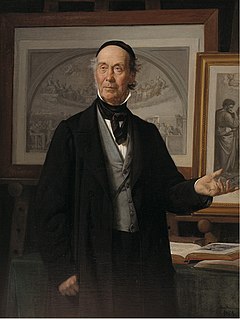
Niels Laurits Andreas Høyen is considered to be the first Danish art historian and critic. He promoted a Danish nationalistic art through his writings and lectures, and exerted a far reaching effect on contemporary artists. His work in various cultural institutions helped steer the development of Danish art during the mid-19th century.

Henry Inman was an American portrait, genre, and landscape painter.

Ammi Phillips was a prolific American itinerant portrait painter active from the mid 1810s to the early 1860s in Connecticut, Massachusetts, and New York. His artwork is identified as folk art, primitive art, provincial art, and itinerant art without consensus among scholars, pointing to the enigmatic nature of his work and life. He is attributed to over eight hundred paintings, although only eleven are signed. While his paintings are formulaic in nature, Phillips paintings were under constant construction, evolving as he added or discarded what he found successful, while taking care to add personal details that spoke to the identity of those who hired him. He is most famous for his portraits of children in red, although children only account for ten percent of his entire body of work. The most well known of this series, Girl in Red Dress with Cat and Dog, would be sold for one million dollars, a first for folk art. His paintings hung mostly unidentified, spare for some recognition in the collections like those of Edward Duff Balken, for decades until his oeuvre was reconstructed by Barbara Holdridge and Larry Holdridge, collectors and students of American folk art, with the support of the art historian Mary Black. Ammi Phillip's body of work was expanded upon their discovery that the mysterious paintings of a "Kent Limner" and "Border Limner" were indeed his.

Staten Island Museum is Staten Island’s oldest cultural institution, and the only remaining general interest museum in New York City.

Jeremiah Pearson Hardy (1800–1888) was a painter who spent most of his career in Bangor, Maine and specialized in portraits. He was also the central figure in a circle of 19th-century Bangor painters that included his daughter, Anna Eliza Hardy (1839–1934), sister Mary Ann Hardy, and pupils Isabel Graham Eaton, Walter Franklin Lansil and George Edward Dale.

Henry Perronet Briggs RA was an English painter of portraits and historical scenes.
Susanna Paine, also known as Susannah and Susan, was an American portrait artist in New England in the 19th century. She published poetry, a Christmas hymn, a novel, and an autobiography entitled Roses and Thorns, or Recollections of an Artist.

Joseph H. Davis was an itinerant American portrait painter. Over a period of only five years, from 1832 to 1837, he painted about 150 watercolor portraits of residents of Maine and New Hampshire. The body of work he left behind is highly regarded for its calligraphic line, miniaturizing delicacy, and decorative stylization. His pictures are in many important collections, including those of the American Folk Art Museum, the Metropolitan Museum of Art, the Museum of Fine Arts, Boston, the National Gallery of Art, the Terra Foundation for American Art and the Strawbery Banke museum in Portsmouth, New Hampshire.

James Hamilton Shegogue was an American painter. He was described as a "man of unusual education, a proficient linguist, and a scientific explorer" by one contemporary.

John Durand was a colonial American portraitist. With John Mare, Abraham Delanoy, and Lawrence Kilburn, he was one of a number of portraitists living and working in New York City during the 1760s.
Nathaniel Rogers was an American painter from Long Island known as the preeminent miniature portrait painter in New York City.


















